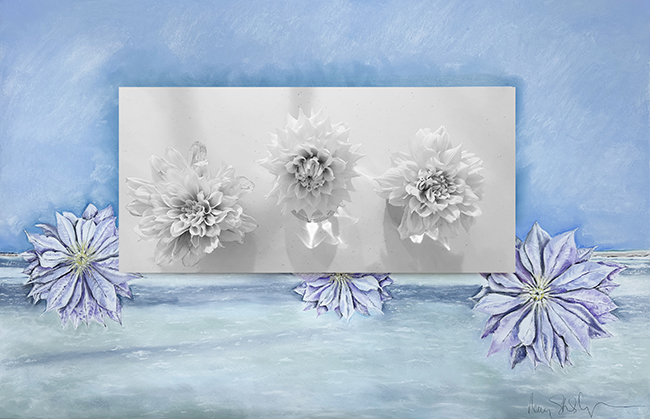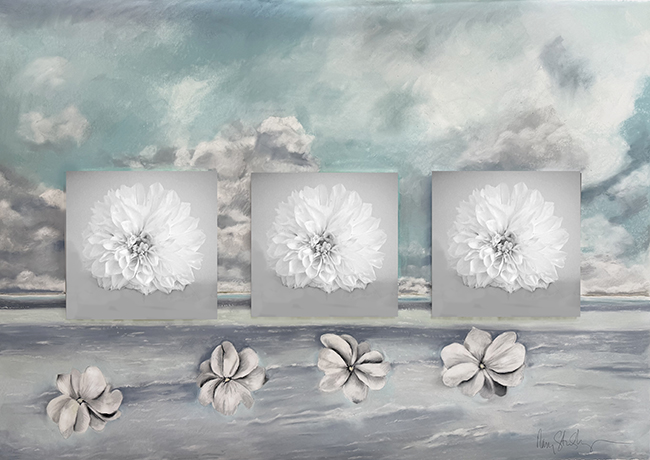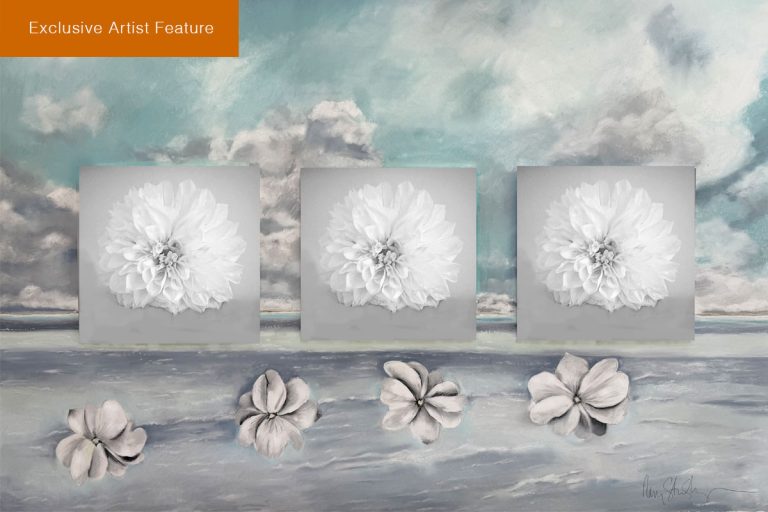Nancy Staub Laughlin is an American pastel artist and photographer with a distinct way of merging two worlds: the immediacy of photography and the softness of pastel. She earned her BFA from Moore College of Art in Philadelphia, PA, and has gone on to show her work at galleries and museums along the east coast. Her pieces sit in both private and corporate collections, and she has been profiled in a variety of media outlets. The art critic and historian Sam Hunter once described her work as “refreshingly unique,” and the phrase fits. Laughlin constructs images that feel ethereal yet grounded, playful yet exact. She draws from the natural world—flowers, skies, clouds, landscapes—but presents them through a structure that feels both dreamlike and composed. Her art rests in the tension between real and imagined space, and in doing so, it offers viewers a chance to linger, question, and be stilled.

The Luminescence of Light
“The Luminescence of Light” is a work that carries its own calm weight. At first glance, one sees a clouded sky rendered in soft pastel tones, with strokes that sweep across the surface like whispers of weather. This sky is not simply a background; it feels alive, filled with shifting atmospheres. Below it lies a body of water, its surface echoing the softness of the clouds, blurring reflection and depth. The scene already has a meditative pull.
Into this world, Laughlin places three square panels. Each panel holds a single white flower, photographed with sharp precision. The flowers bloom against gray backdrops, luminous in their simplicity. They interrupt the painted surface yet also seem at home within it. Beneath them float hand-drawn blossoms, pale and spectral, tethered to the water’s skin.
The effect is layered and disorienting. What is real? What is drawn? The flowers exist both as photographs—detailed, tactile, captured in stillness—and as pastel sketches, airy and fading. The tension between permanence and transience is quiet but undeniable.
The work reads almost like a stage set, a performance where elements of nature play different roles. The sky and water hold the mood. The photographed flowers stand as actors, luminous and poised. The drawn flowers become echoes, fragile and fading notes of memory.
Laughlin’s choice of white blooms is important. Stripped of color, they rely on form, light, and shadow. They glow against the gray, reminding us that illumination does not always require vibrancy; sometimes it is the absence of color that sharpens vision. “The Luminescence of Light” is less about objects and more about states of being. It is about how light settles, how reflection blurs, how memory fades yet still persists.

The Radiance of the Illumination
If “Luminescence” whispers, then “The Radiance of the Illumination” carries a brighter tone. Here, the pastel backdrop is a sweep of cool blues. The water is calmer, more crystalline, edged with a serenity that feels endless. Across this scene, star-like blossoms float, each tinted with delicate blues and violets, their points radiating outward. These flowers are less spectral than in the first work—they seem anchored, part of the surface rather than hovering above it.
Set against this painted expanse is a rectangular photographic panel, again featuring three flowers. Each bloom sits upright, vivid in its grayscale capture. Their petals reach outward with quiet force, their symmetry bold against the softness of the painted sea. The central flower dominates, its core sharp, almost architectural.
The layering here feels more direct. The flowers in the photograph are assertive, presenting themselves as undeniable presences. In contrast, the painted blossoms spread like extensions of water, drifting yet sure. The eye moves between the sharpness of photography and the delicacy of pastel, never settling, always shifting.
This tension is where the work finds its radiance. It is not in the brightness of color but in the dialogue between two mediums. The pastel world is dreamlike, expansive, light. The photographed flowers are rooted, undeniable, grounded in the real. Together, they create a field of oscillation. The viewer is asked to step between these realms, to consider how memory, perception, and presence interact.
Where “Luminescence” leaned into transience, “Radiance” leans into persistence. The flowers here feel less fleeting, more like anchors of experience. Yet the blue expanse softens that solidity, reminding us that nothing is entirely fixed.
Closing Thoughts
Nancy Staub Laughlin’s work is about dualities: photography and pastel, sharpness and softness, permanence and impermanence. In “The Luminescence of Light” and “The Radiance of the Illumination,” she invites viewers into spaces where natural forms are at once familiar and otherworldly. Her flowers, skies, and waters do not merely represent—they converse. They speak to memory, to perception, to the way light itself can hold us.
Laughlin has built a practice that resists easy classification. Her works are part landscape, part still life, part dream. They are about looking more than they are about arriving. They remind us that light, whether luminous or radiant, is always shifting, always teaching us to see anew.

